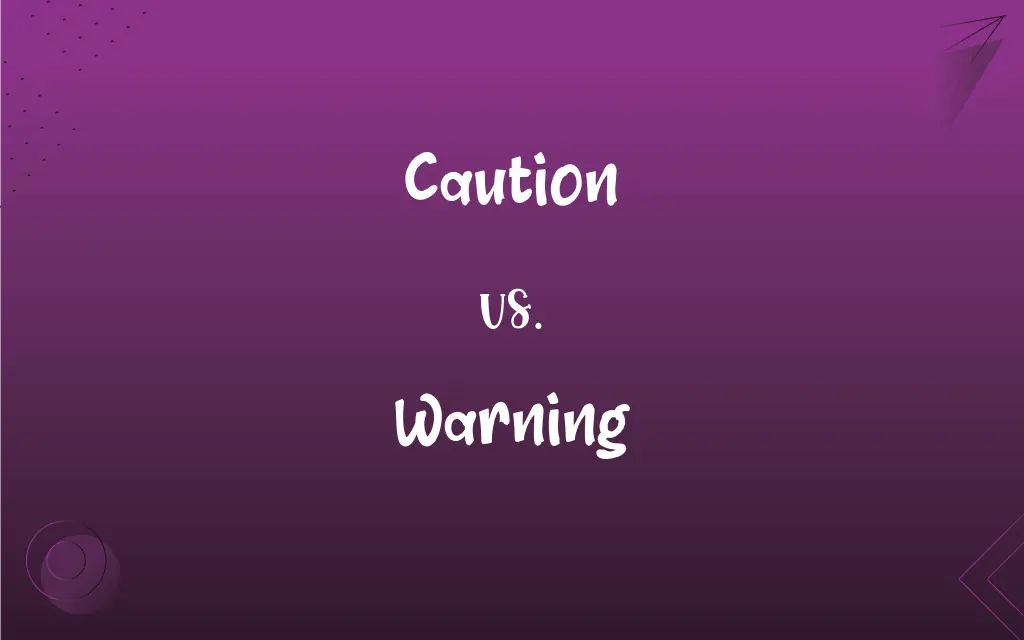Caution vs. Warning: What's the Difference?
Edited by Janet White || By Harlon Moss || Published on November 11, 2023
Caution refers to carefulness to avoid danger, while a warning is a direct notification about a present or impending danger or problem.

Key Differences
Caution is an attitude or practice of being vigilant and taking measures to avoid potential harm or danger. Warning, conversely, is a more direct indication or advice about a specific imminent threat or issue.
While "caution" often suggests a general state of alertness, "warning" typically implies a more immediate or specific threat. One might exercise caution in a new environment, but a warning would be given if there's a known danger in that place.
Caution can be both proactive and reactive, encouraging individuals to tread carefully based on general knowledge or instincts. A warning is more often reactive, serving as a response to a known hazard or potential problem.
It's common to see caution used in contexts where one is advised to be prudent, such as in decision-making or assessing situations. Warnings, meanwhile, often precede immediate threats like inclement weather, faulty equipment, or dangerous areas.
In many safety protocols, cautions are given as preliminary advice to be watchful, whereas warnings are more urgent and are given when the risk is higher or more imminent.
ADVERTISEMENT
Comparison Chart
Nature
An attitude or practice
A direct notification
Immediacy
Often general alertness
Implies a more immediate threat
Usage
Advisory based on general knowledge or instincts
Direct response to a known hazard
Severity
Suggests vigilance, lower risk
Indicates higher risk or imminent danger
Example Situations
New environments, decision-making
Inclement weather, dangerous areas, faulty equipment
ADVERTISEMENT
Caution and Warning Definitions
Caution
The act of being cautious.
He approached the wild animal with caution.
Warning
A statement or action that advises of a potential future problem.
The weather forecast issued a warning for heavy rain.
Caution
A formal warning given to someone.
The player received a caution for his aggressive behavior.
Warning
An indicator giving notice of a possible danger.
The flashing lights were a warning that the train was approaching.
Caution
A warning or proviso of specific stipulations.
The contract comes with a few cautions.
Warning
The act of informing someone of a risk or threat.
The lifeguard gave a warning to swimmers about the strong currents.
Caution
Care taken to avoid danger or mistakes.
Always exercise caution when crossing the street.
Warning
A sign or message cautioning against certain acts.
The label on the bottle had a warning against ingestion.
Caution
A careful attitude or way of behaving.
She drives with a lot of caution.
Warning
A formal admonition about behavior or conduct.
The employee received a warning for tardiness.
Caution
Careful forethought to avoid danger or harm.
Warning
A statement telling of or an indication providing evidence of impending danger, difficulty, or misfortune
The government issued a warning about unsafe drinking water. The shelf collapsed without any warning.
Caution
Close attention or vigilance to minimize risk
The car proceeded over the rickety bridge with caution.
Warning
Advice to be cautious
A word of warning to runners about the hot weather.
Caution
Prudence or restraint in action or decision
Advised caution in choosing a school.
Warning
A cautionary or deterrent example
The incident is a warning to careless investors.
FAQs
How are cautions used in legal contexts?
In legal contexts, a caution can be a formal warning given to someone about their behavior or actions.
Which is more severe, a caution or a warning?
Generally, a warning indicates a higher or more immediate risk than a caution.
Why might someone heed a caution but ignore a warning?
They might perceive cautions as general advice while underestimating the immediacy or severity of a warning.
How do road signs use cautions and warnings?
"Caution: Children at play" advises vigilance, while "Warning: Sharp curve ahead" alerts drivers to a specific hazard.
How does a warning differ from a caution?
A warning is a direct notice about an imminent threat, while a caution advises general carefulness.
Can you give an example where both caution and warning are used?
A construction site might have a sign saying "Exercise caution: Falling debris" and another sign giving a "Warning: Hard hats required."
In safety protocols, how are cautions and warnings typically presented?
Cautions are often preliminary advice, while warnings indicate immediate threats or areas of high risk.
Can the terms caution and warning be used interchangeably?
While related, they aren't always interchangeable. Caution is about carefulness, whereas a warning directly points to a specific danger.
How do different industries use cautions and warnings?
Industries use cautions for general safety practices and warnings for specific hazards or dangers.
Why are warnings more prevalent in certain products or areas?
Products or areas with higher potential risks will have more warnings to ensure user safety.
Are there cultural differences in interpreting cautions and warnings?
Yes, cultural norms can influence how seriously cautions or warnings are taken.
What's the significance of colors like yellow and red with cautions and warnings?
Yellow often signifies caution or general alertness, whereas red indicates immediate danger or a warning.
Why do some public spaces lack both cautions and warnings?
Some spaces are deemed low-risk, or it's assumed that visitors will exercise inherent carefulness.
What is the primary purpose of a caution?
The primary purpose of a caution is to advise vigilance and carefulness to prevent harm or mistakes.
How are cautions and warnings conveyed in user manuals?
Manuals may use "CAUTION" to advise safe usage and "WARNING" to highlight potential harm if directions aren't followed.
How do verbal cautions and warnings differ?
Verbal cautions advise carefulness, while verbal warnings directly indicate imminent threats.
Can ignoring a caution lead to situations that then require a warning?
Yes, ignoring initial cautions can escalate situations, prompting more urgent warnings.
In literature, how might authors use cautions and warnings in storytelling?
Authors might use cautions to create tension and warnings to signify pivotal or climactic moments.
Can a caution ever be more severe than a warning?
Context matters; in some specific cases, a caution might be perceived as more severe based on wording or presentation.
How do digital platforms use cautions and warnings?
Digital platforms use cautions for general guidelines and warnings for actions that can cause irreversible changes or threats.
About Author
Written by
Harlon MossHarlon is a seasoned quality moderator and accomplished content writer for Difference Wiki. An alumnus of the prestigious University of California, he earned his degree in Computer Science. Leveraging his academic background, Harlon brings a meticulous and informed perspective to his work, ensuring content accuracy and excellence.
Edited by
Janet WhiteJanet White has been an esteemed writer and blogger for Difference Wiki. Holding a Master's degree in Science and Medical Journalism from the prestigious Boston University, she has consistently demonstrated her expertise and passion for her field. When she's not immersed in her work, Janet relishes her time exercising, delving into a good book, and cherishing moments with friends and family.







































































